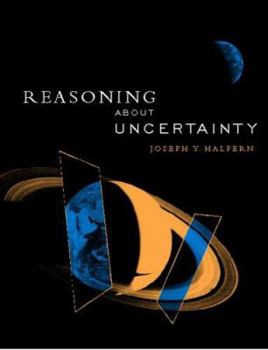Reasoning about Uncertainty
Select Format
Select Condition 
Book Overview
Formal ways of representing uncertainty and various logics for reasoning about it; updated with new material on weighted probability measures, complexity-theoretic considerations, and other topics.In... This description may be from another edition of this product.
Format:Paperback
Language:English
ISBN:0262582597
ISBN13:9780262582599
Release Date:January 2005
Publisher:MIT Press
Length:497 Pages
Weight:1.75 lbs.
Dimensions:1.0" x 7.0" x 9.1"
Age Range:18 years and up
Grade Range:Postsecondary and higher
Customer Reviews
2 ratings
clear, interesting, insightful
Published by Thriftbooks.com User , 16 years ago
This book guides you through formal systems useful for reasoning about uncertainty. If you've ever wondered about the rationale for probability theory or for ways to overcome its limitation, this is the book for you. The author made an effort to make the book as self-contained as possible (a remarkable achievement given what it covers), so this book is very clear. The examples are short, but illuminating and motivating, so this book is interesting. The author always tries to justify why the axioms of a theory were chosen a certain way, so this book is insightful. Even if you have just a passing interest in probability theory, I highly recommend this book. It will not only give you reasons for the definitions in probability theory, but also powerful alternative (and often complementary) ways of reasoning about uncertainty.
Deep look at the logic of uncertainty
Published by Thriftbooks.com User , 18 years ago
If you're completely at home with first-order logic and with probability, you're may be ready to extend some of those ideas. This book examines a range of topics that push logic and probability into wider, more interesting areas. After a brief introduction, Halpern introduces upper and lower probabilities representing partial knowledge, and other measures representing belief, plausibility, possibility, and necessity. These are built up in a rigorous way, but with plenty of physical significance at each step - these aren't just axiomatic systems put together for their inherent elegance. The next few chapters build up a logical sequence of constructs around these measures, including independence, conditioning, and expectation. I expected to see confidence intervals generalized into these terms, but Halpern may have considered those to be exercises for the reader. From these pieces, Halpern builds frameworks for real-world decision making. This includes the ability update knowledge (and ignorance) in the presence of new facts. It also includes modal logics, based on the variability of "truth" according to the time at which an assertion is made or the person by whom it it made, and "counterfactuals" that reason about events that could have occurred but didn't. And, whenever Halpern presents a new approach, he's also careful to point out where its weaknesses are. This isn't for beginners, by any means. The successful reader is flexible about the axioms to use in an analytic system, and is able and willing to follow along with dense logical notation. One should not expect this to cover the whole world of soft logics - traditional fuzziness gets only brief mention, for example. The best parts of this presentation extend familiar probabilistic terms (such as expectation) well beyond their original frameworks, creating a more unified view of various belief measures than I've seen elsewhere. If you have a serious interest in soft logic, formal reasoning, and mathematical tools for AI, I recommend this book very highly. -- wiredweird





